She did not want to give up power during her husband's lifetime or after his death. "There can be only one queen," said Jadwiga Kaliska openly. And even as a seventy-year-old woman, she was still shaking Polish politics.
Władysław Łokietek was the head of the Polish state. But it was his wife Jadwiga who was the neck on which that head rested. This state of affairs was not questioned by anyone on the Vistula - not even the king himself.
Jadwiga's merits can be multiplied. Even before Łokietek became king, she saved his skin many times. It was she who protected the princely sons when the ruler fled the country, and the duchess was forced to hide in the guise of a simple townswoman. Then, in the face of the greatest rebellion in the history of medieval Krakow, she personally began to defend Wawel. Meanwhile, the elbow slipped away again somewhere, leaving her to die ...
I wrote about these episodes in another article (click to read it). It must be said, however, that Jadwiga's influence only grew over time. And the older Łokietek was, the more he made him look like a henchman.
More important than the king
Queen Jadwiga Kaliska, crowned together with her husband in 1320, presented herself in the documents as if it was she who ruled at Wawel. She emphasized that she was surrounded by the same majesty as the brightest gentleman; that he makes his decisions, like him, on the advice of the most important barons of the kingdom.
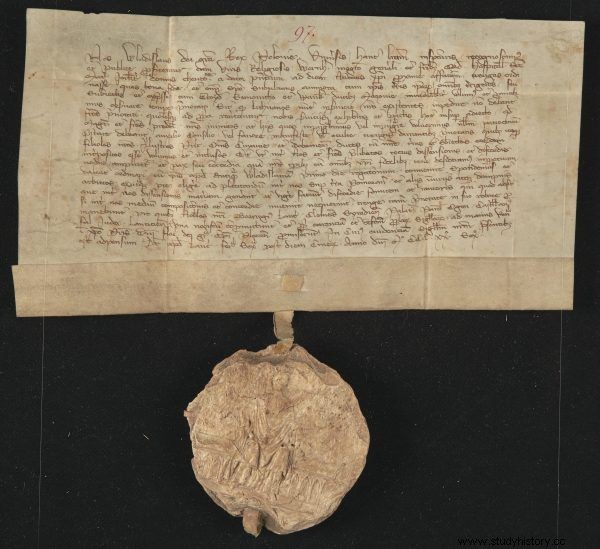
Document of Władysław Łokietek with the seal of the ruler. The king did not mind putting the piston of his main seal into the hands of his wife.
In 1331, as befits the number one person, she conducted disputes at the highest level with the bishop of Lubusz, assuring him that it was she who could take proper care of his property. The best proof of Jadwiga's influence comes from 1329.
The document was then issued by the king, stating that ... he could not put his main seal under the letter, because his wife went on a journey and took it with her. The information sounds innocent at first glance. Let us remember, however, that the seal was one of the most important instruments of power in this era. With her help, the queen could make almost any decisions, automatically confirmed by the authority of Władysław Łokietek.
As you can see, the king did not mind lending Jadwiga so much power. And he was even inclined to assume that the seal would be more useful to his wife than to him ...
There can only be one queen
The unique position of the queen, as well as her extraordinary pride and self-esteem, made itself known again immediately after the death of Władysław Łokietek.
On March 2, 1333, devastated by constant defeats and bent under the weight of old age, Władysław the Short gave up his ghost. He has suffered, as is suspected, an attack of paralysis. The twenty-three-year-old heir to the throne, Kazimierz (today known as Casimir the Great) quickly set about preparing his coronation.
Of course, he wanted not only him to be anointed in the Wawel cathedral, but also Aldona Anna, married to him, who was to become the new Polish monarch. The matter was obvious to him. But not for the queen mother, Jadwiga. The powerful widow of Władysław Łokietek was over sixty years old, but she was in no hurry to retire. She immediately protested firmly.
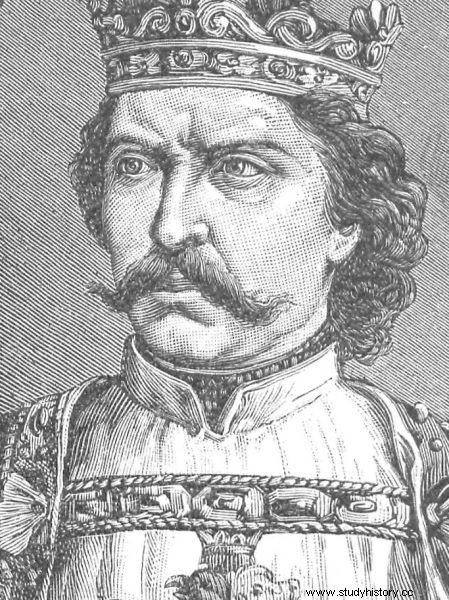
Władysław Łokietek in the portrait of Fr. Pillati.
"According to the law, there can be no question of a new coronation, because I am alive, the true crowned queen. Therefore, until I die, the second woman should not be elevated to the rank of queen in the same kingdom, ”she objected, which was noted by a well-informed chronicler. The dispute was fierce, and Jadwiga consistently refused to give up her power.
She did not like Aldona Anna and could not come to terms with her free, cheerful nature, which the chronicler Jan Długosz would write about years later. Maybe she even told herself that a Lithuanian girl, known for her love of fun, had a bad influence on her son.
The dignified matron was a princess and then queen for four long decades. She could not imagine that a neophyte devoid of seriousness would be able to replace her. After all, the girl did not have the skills and knowledge needed to establish favorable relations with the Holy See, properly position the bishops, and especially - to guide young Kazimierz at the most difficult stage of his rule ...
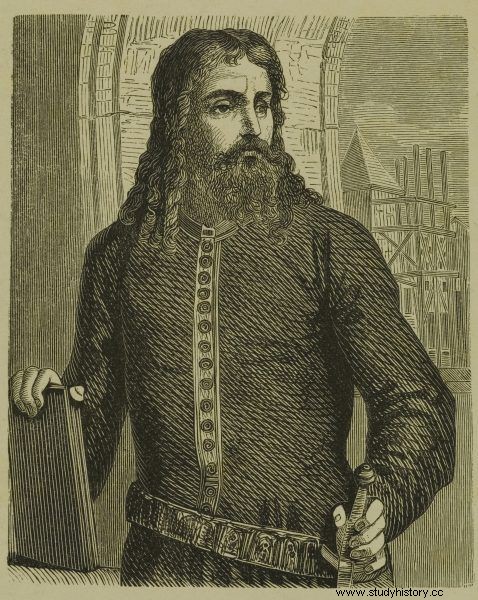
King Kazimierz in his young years. Graphics by Franciszek Ejsmond from the second half of the 19th century.
The Queen Mother's resistance could have led to a devastating civil war. Jadwiga was, however, not only a proud matron, but also:a good ruler, able to put the affairs of the state, especially the dynasty, above her own interest.
Finally, willy-nilly, she graciously yielded to the pleas of her son, whom she loved very tenderly. This is another chronicle note. Kazimierz became the new king, Aldona Anna was crowned queen, against the wishes of her mother-in-law. But that does not mean that Jadwiga has stepped back into the shadows. Even in her retirement, she shook the world of Polish politics.
The Pope's favorite
The monarch said goodbye to Wawel, choosing Sącz for her new residence. Here, as the king's widow, she still had full power, and her son made no attempt to meddle with her decisions. Meanwhile, she constantly considered herself a legal ruler.

The amazing story of women who built the Polish power. Jadwiga Andegaweńska and her predecessors in a new book by Kamil Janicki:"Ladies of the Polish Empire".
This is also how the most important leaders of the Christian world treated her. For example, when the pope, John XXII, sent his legate to Poland in 1334, it was customary to inform the local queen about it. However, he sent the letter only to ... old Jadwiga, "forgetting" that the ruler's current spouse was Aldona Anna.
In the documents of Jadwiga from 1333 there is a formula: "Queen of Poland, lady of the Sądecki region". The monarchs issued full diplomas, extremely actively managing her small state on the Polish-Hungarian border. She brought colonists, founded villages, rewarded loyal subjects. She also settled court disputes, such as the conflict over the mill between the presbytery from Nowy Sącz and local village heads.
Mother knows better
The provincial skirmishes with the flour in the background, however, could not be enough to satisfy the ambitions of the queen mother. It wasn't long before she started re-meddling with big politics. Its court in Nowy Sącz was visited by the highest dignitaries of the state. The castellan of Kraków came there; The chancellor himself also appeared - Kazimierz's right hand. This does not mean, however, that the officials were plotting together with Jadwiga and against the new king. Contrary. Knuli for his benefit.
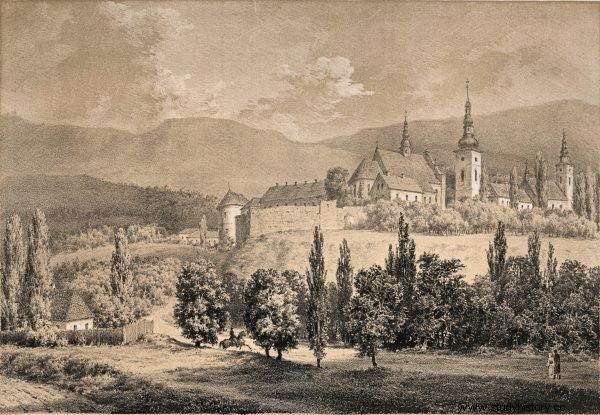
Panorama of Stary Sącz with a visible monastery of Poor Clares. A drawing by Napoleon Orda.
Jadwiga, to put it briefly and bluntly, clearly did not believe in her son. That he would be able to replace his father, that he would cope, that everything she left him would not be forfeited. A new political party began to form around the aged queen. Historians suspect that it was largely due to her radical tightening of relations between Poland and Hungary.
Jadwiga's daughter, Elżbieta Łokietkówna, ruled in the south, increasingly marginalizing her ailing husband - Karol Robert of the Anjou family. Together, the two queens helped Kazimierz, still inexperienced and clumsy, hold the throne.
With their undoubted participation, a breakthrough congress was organized in Visegrad in 1335, at which the Czechs renounced their claims to the Polish crown for a hefty fee, and the Teutonic Knights temporarily gave up the war with Piast.
It seems highly probable that the dynastic pact between the Piasts and the Angevins, known from the following years, was established with the mediation of the queen mother. Under it, none other than the Hungarian Queen Elżbieta Łokietkówna was to inherit the Polish throne in the event of a childless death of Kazimierz. The pact will not only gain force in the future , but also - it will pave the way to the Polish crown for another, much better known Jadwiga. Holy Queen, Anjou.
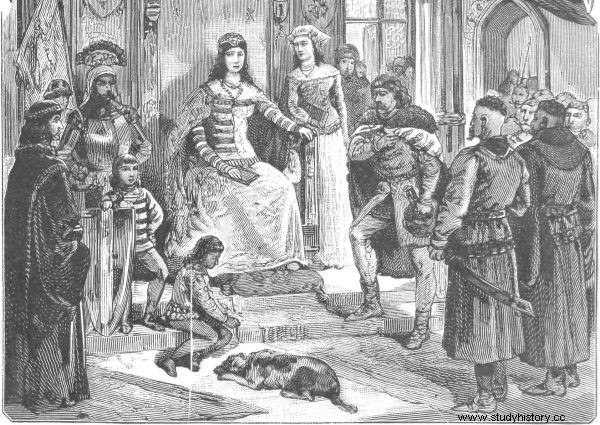
Elżbieta Łokietkówna in the vicinity of the manor house in the graphics of Fr. Pillati
A well-deserved rest
For Jadwiga, who was approaching seventy, it was the last great success. Awareness that, if necessary, daughter (already known then as an agile and effective politician) she would take matters into her own hands, she felt calm. And it allowed me to start seriously thinking about the inevitable.
A godly old woman, always closely associated with the Church, decided to follow in the footsteps of her pious predecessors. Both Jadwiga's mother, Jolenta, and her aunt Kinga joined the convent of Poor Clares right after their husbands' death. The widow of Łokietek was reluctant to make a similar decision, which would amount to the final handing over of the stick to the next generation.
She convinced herself that she still had too many pressing matters to attend to. But when she finally pushed through the succession agreement, she was no longer able to soap her eyes. She knew that her health was declining and that if she wanted to prepare for death, there was not much time left for it.

It was partly due to Queen Jadwiga that the throne in the future passed into the hands of her namesake and great-granddaughter:Jadwiga Andegaweńska.
Reluctant retiree
Finally, she put on a monk's habit, having remained a Poor Clare in the monastery in Stary Sącz, which provided education for her daughter and who remained faithful to her throughout the years of her reign. However, she clearly could not come to terms with the rules of religious life. Or maybe just - she too late to conclude that her decision was premature after all.
She still maintained a large court, politicized, and had a clear problem with sitting still. She was tight not only in the monastery cell, but also in Sącz itself. In 1339, she decided to travel to Hungary to visit her daughter and see her grandchildren, whom Kazimierz was unable to provide. She applied for a special papal permit - allowing accommodation not only in Polish, but also in Hungarian cloistered monasteries. However, she did not manage to use it.
On December 10, she died within the walls of the monastery in Nowy Sącz. She was buried there too.
***
One article is far too little to describe the extraordinary figure of Władysław Łokietek's wife. Learn much more about Queen Jadwiga Kaliska from my new book: Ladies of the Polish Empire. The Women Who Built a Power " . You can buy it now at empik.com.
Selected bibliography:
The article was based on materials collected by the author during the work on the book "Ladies of the Polish Empire. The Women Who Built a Power " . Some of these items are shown below. Full bibliography in the book.
- Długopolski E., Władysław Łokietek against the background of his times , Universitas, Krakow 2009.
- Jasiński K., Supplement to the genealogy of the Piasts. Completion. Jadwiga, wife of Władysław Łokietek , "Studia Źródłoznawcze", vol. 5 (1960).
- March A., "Domina Terrae Sandecensis". The political role of Queen Jadwiga Łokietkowa in the context of her relations with the dignitaries of Lesser Poland (1305–1339) , "Kwartalnik Historyczny", vol. 107 (2000).
- Marzec A., Jadwiga Łokietkowa (1270 / 1275–1339) [in:] Polish rulers , ed. B. Czwojdrak, M Publishing House, Krakow 2017.
- Ożóg K., Jadwiga [in:] The Piasts. Biographical Lexicon , edited by K. Ożóg, S. Szczur, Wydawnictwo Literackie, Krakow 1999.
- Rácz G., The Congress of Visegrád in 1335:Diplomacy and Representation , Hungarian Historical Review, vol. 2 (2013).
- Samsonowicz H., Elbow-high times , National Publishing Agency, Krakow 1989.
- Sroka S.A., Władysław I Łokietek [in:] The Piasts. Biographical Lexicon , edited by K. Ożóg, S. Szczur, Wydawnictwo Literackie, Krakow 1999.
- Szczur S., Visegrad Convention of 1335 , "Historical Studies", vol. 35 (1992).
- Śliwiński J., The marriages of Casimir the Great. A study in the field of morality and ethics of the royal court in Poland in the 14th century , Pedagogical University in Olsztyn, Olsztyn 1987.
